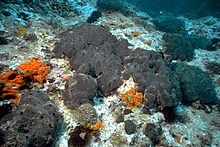Spongia officinalis
| Spongia officinalis | |
|---|---|

| |
| Scientific classification | |
| Kingdom: | |
| Phylum: | |
| Class: | |
| Order: | |
| Family: | |
| Genus: | |
| Species: | S. officinalis
|
| Binomial name | |
| Spongia officinalis | |
Spongia officinalis, better known as bath sponge, is a commercially used sponge. It is found throughout the Mediterranean Sea.[2][3][4][5]
It is a hermaphroditic animal and can reproduce asexually by means of budding or through sexual reproduction. When alive, its color is dark grey; upon drying it becomes either yellow or brown. Young larvae swim freely until they attach themselves to the sea floor or other adequate ground. After that, they start growing slowly, as it may take as much as 40 years to grow the size of a baseball.[6]
Harvesting has led to a decrease in population.
Distribution
Mediterranean Sea, Caribbean Sea and West Indies.[3]
References
- ^ Linnaeus, C. 1759: Systema naturæ per regna tria naturæ, secundum classes, ordines, genera, species, cum characteribus, differentiis, synonymis, locis. Tomus II. Editio decima, reformata. - pp. [1-4], 825-1384. Holmiæ. (L. Salvii).
- ^ Laubenfels, M.W. de. 1953: A guide to the sponges of Eastern North America. University of Miami Press. 32p.
- ^ a b Díaz, Humberto, Bevilacqua, Marina & Bone, David (1985). Esponjas del Parque Nacional Morrocoy. Fondo Editorial Acta Científica Venezolana. Caracas. 64p.
- ^ Cook, S.D.C., & Bergquist, P.R. 2002: Family Spongiidae Gray, 1867. Pp. 1051-1060. In Hooper, J. N. A. & Van Soest, R. W. M. (ed.) Systema Porifera. A guide to the classification of sponges. 1 (Kluwer Academic/ Plenum Publishers: New York, Boston, Dordrecht, London, Moscow).
- ^ Rützler, K., R. W. M. van Soest. & C. Piantoni. 2009: Sponges (Porifera) of the Gulf of Mexico, Pp. 285–313 in Felder, D.L. and D.K. Camp (eds.), Gulf of Mexico–Origins, Waters, and Biota. Biodiversity. Texas A&M Press, College Station, Texas.
- ^ Esponjas (Esponjas de baño). Pp: 111. 1980: En; Diccionario Monográfico del Reino Animal. Biblograf, S.A. España. ISBN 94-71533-385-5
External links
- Spongia officinalis info
- World Register of Manine Species
- Integrated Taxonomic Information System: Spongia officinalis Taxonomic Serial No.: 47545
- ZipCodeZoo.com: Spongia officinalis (Dalmatische Spons;badspons)
- Biodiversity Heritage Library (BHL): Spongia officinalis
Wikimedia Commons has media related to Spongia officinalis.
Wikispecies has information related to Spongia officinalis.
